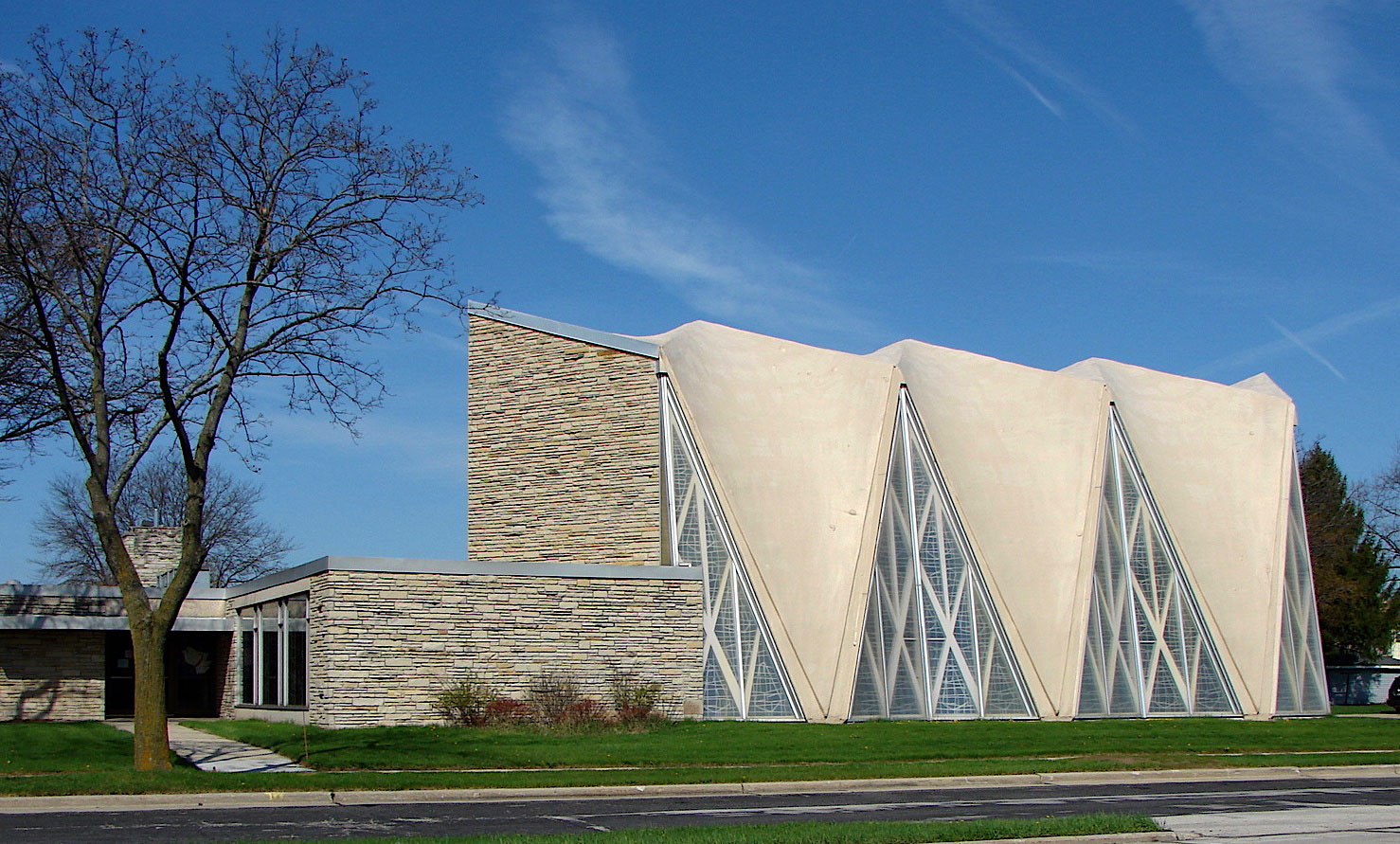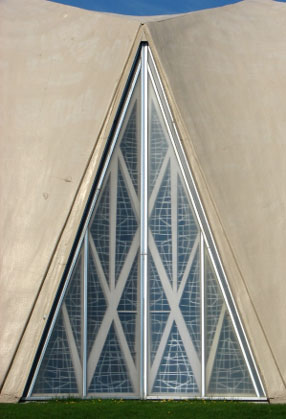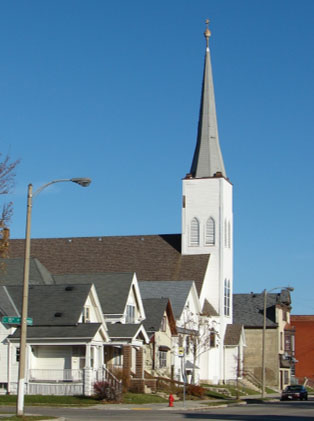62. Zion Evangelical and Reformed, 1958
Now Zion United Church of Christ
3301 South 76th Street (at Ohio Avenue)
Architect: William Wenzler

A small group of German-speaking Milwaukee residents formed Zion Evangelical Church in 1883, and built a wooden church on the South Side in 1887. That building is still standing, on the north side of Greenfield Avenue between 14th and 15th Streets. With its central tower and steeple reaching more than 120 feet in height, it is the tallest wooden church in the city.
After nearly 70 years in the Greenfield Avenue church, the congregation decided in the mid-1950s to build a new place of worship. The church acquired property more than four miles to the southwest of its building on Greenfield Avenue, in an area then undergoing development that had just been annexed by the City of Milwaukee. In the post-World War II period, churches and synagogues throughout the city were following their members to the newer, outermost neighborhoods of the city and to the suburbs. By this time, the name of the church had been changed to Zion Evangelical and Reformed, reflecting the 1934 merger of the formerly separate Evangelical and Reformed denominations. The name was changed a second time, to Zion United Church of Christ, just a few years after completion of their present church. This was a result of the merger of the Evangelical and Reformed Church with the Congregational Church, forming the United Church of Christ.
The congregation turned to the young architect William Wenzler, not yet 30 years old, to design the new church and its related facilities. Born in Milwaukee in 1929, Wenzler received a degree in architectural engineering from the University of Illinois. Following his graduation in 1952, he worked in the office of Milwaukee architect Alfred Siewert and for the partnership of Brust and Brust before establishing his own firm in 1955. Wenzler had a varied practice, with most of his commissions in southeastern Wisconsin. Among these were at least 11 churches that were built between 1957 and 1984. In addition to Zion Evangelical, Wenzler designed two other churches in Milwaukee and five in nearby suburban communities. Several of his churches exhibit distinctive, sculptural forms and unusual structural systems, including Zion Evangelical and the later Calvary Baptist.
Construction of Zion Evangelical began in April of 1958 and was completed a year later. The congregation built a large classroom and office addition several years later, so that the church is now the northernmost wing of a much larger building. The church stands out due to its striking form, but the entire building is visually unified by a veneer of rough-cut stone laid in irregular courses. The end walls of the church are stone, while the side walls and roof consist of ten hyperbolic paraboloid forms executed in reinforced concrete.
Hyperbolic paraboloids can assume a variety of forms. As used in this church, they are diamond-shaped panels whose surfaces are parabolic curves along the axes between opposing corners. The result is a saddle-like shape, with a concave curvature in one direction and a convex curvature in the perpendicular direction. Six of these forms make up the side walls and portions of the roof. They were precast, set in place and bolted together at their corners, leaving triangular voids along the side walls. These voids are filled with stained glass, supported by a structural framework that forms a series of diamond shapes, mimicking the shapes of the hyperbolic paraboloids. The four roof forms were cast in place and connect to the six wall forms along their edges. The outer surfaces of the ten hyperbolic paraboloids are covered with an elastic vinyl coating.
Zion Evangelical was Wenzler’s second use of the hyperbolic paraboloid form in a place of worship. His design for St. Edmund’s Episcopal Church in the suburban community of Elm Grove, completed in 1957, includes a single hyperbolic paraboloid roof of concrete that spans the entire worship space. St. Edmund’s Episcopal and Zion Evangelical were two of the earliest uses of this building technology in the United States. So innovative were these two church designs that they were profiled in the Italian architectural journal L’architettura; Cronache e Storia. Zion Evangelical was also featured in an article in The Wisconsin Architect in 1962.
Sources:
“Chiesa Protestante a Milwaukee, Wisconsin,” L’architettura; Cronache e Storia, March 1961, pages 734-37.
“Zion E and R Will Dedicate,” Milwaukee Sentinel, April 4, 1959, part 1, page 12, column 1.
“Zion Evangelical and Reformed Church,” The Wisconsin Architect, December 1962, pages 12-14.
Zion United Church of Christ, website at zionuccmilw.org.

